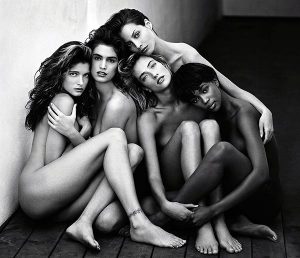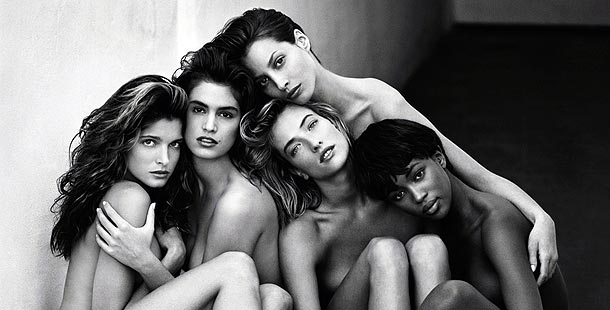
Though Herb Ritts died in 2002 from pneumonia, his legacy lives on, especially in the photos he shot from the modelling world. Someone needs to write a non-fiction book about supermodels, chronicling their rise to celebrity status, and how the role evolves in a world where magazines dwindle and marketing campaigns claim what covers are left.
It occurred to me the other day that there aren’t a lot of books on the history of supermodels, other than the token coffee table books put out by Sports Illustrated.
And that kind of sucks.
Really is such a huge part of pop culture only worthy of a photo book with quick blurbs on the experiences of models on a particular photo shoot? There are so many more stories behind the pretty faces of supermodels.
I’d like to think so. Given my interest in writing more cerebral copy on pop culture, I bounced an idea off my wife. I told her it would be interesting to write a non-fiction book on supermodels, sitting down with them (from Lesley Hornby to Kate Upton) in their milieu, and ask them about the pressures, the struggles and triumphs they’ve all faced during their careers.
In particular the bombardment of negativity from media, special interest groups and critics.
These days, I work as a journalist. And I typically cover stuff that I like: sports, music, movies and other pop cultural trends. I think journalists like to focus on their interests when they get into the industry, and continue with it once they’ve paid their dues.
So, I’d like to write a book, with a journalistic approach, on the history of supermodels, directly interviewing the movers and shakers of that career path. The interesting thing about the supermodel these days is their numbers are in limited supply, and their much coveted quarry, the front covers of magazines, has been relegated to marketing by the agents of actresses, singers and other personalities outside of the modelling world.
In recent memory, I can only recall Chrissy Teigen and Kate Upton grabbing covers of magazines as I waited in queue at the grocery store. Perhaps there was a Gisele cover mixed in there as well.
That’s one of the big issues I’d like to tackle. That and how empires like Sports Illustrated and Victoria’s Secret keep the supermodel relevant in the wake of changing media and fashion industries. Another topic I’d like to focus on his the trends even in the modelling world. The Swinging Sixties were entrenched in London, England; the Eastern European invasion and the rise of the Brazilian model.
So, I’ve thought about looking into starting up a Kickstarter campaign to help cover the costs of jet-setting the globe to interview the models, the photographers, and even the designers about the world of supermodels.
Then there’s the actual arrangement of interviews. That will take a lot of work to establish a network of contacts. As a journalist who covers sports and arts, it might be a little bit easier, then again, working for a small publication, it might not.
But it’s not like I’ve interviewed models before. For four years I wrote for the Canadian men’s periodical, Urban Male Magazine.
Still, it’s a great idea to encapsulate a section of popular culture. From the aforementioned Twiggy (Hornby) and Jean Shrimpton to Janice Dickinson to touching on the Gia Carangi story, and then the supermodel explosion where the famous quote by Canadian Linda Evangelista: “We don’t wake up for less than $10,000 a day” was uttered in the late ’80s.
So that part would include Cindy Crawford, Naomi Campbell, Claudia Schiffer, Tatjana Patitz and so forth. You’ve also got the Heroin chic days of Kate Moss and Jaime King.
Then moving on to the popularity of Victoria’s Secret, the consistency of Sports Illustrated, and where the supermodel is slowly coming back into focus especially with Candice Swanepoel earning Maxim‘s No. 1 spot on their Hot 100 list.
That’s not just one instance. In an interview I had with Canadian model Ashley Diana Morris for Urban Male Magazine, she told me the supermodel is coming back.
So why not flesh that fixture of pop culture with a historical look on what it means being a supermodel via interviews with some of the biggest movers and shakers involved. Gisele, Cindy, Elle, Naomi, Tyra, Alessandra, Helena, etc., etc.
And while we’re at it, possibly get Canadian fashion photographer Raphael Mazzucco to do a forward?
Let’s see if this idea gets some traction.

